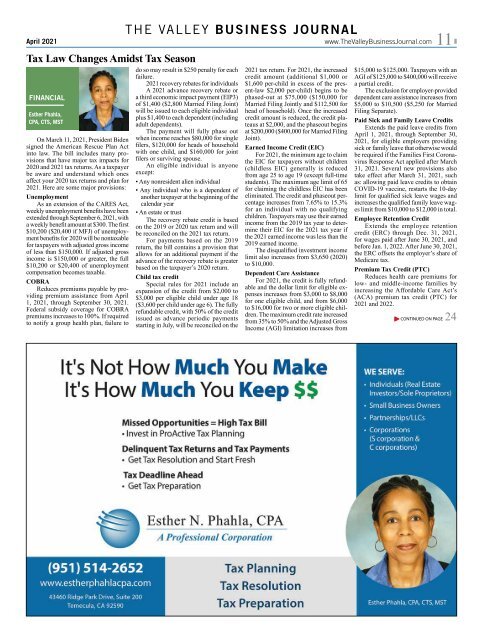VBJ April 21 Online
Create successful ePaper yourself
Turn your PDF publications into a flip-book with our unique Google optimized e-Paper software.
<strong>April</strong> 20<strong>21</strong><br />
Tax Law Changes Amidst Tax Season<br />
FINANCIAL<br />
Esther Phahla,<br />
CPA, CTS, MST<br />
On March 11, 20<strong>21</strong>, President Biden<br />
signed the American Rescue Plan Act<br />
into law. The bill includes many provisions<br />
that have major tax impacts for<br />
2020 and 20<strong>21</strong> tax returns. As a taxpayer<br />
be aware and understand which ones<br />
affect your 2020 tax returns and plan for<br />
20<strong>21</strong>. Here are some major provisions:<br />
Unemployment<br />
As an extension of the CARES Act,<br />
weekly unemployment benefits have been<br />
extended through September 6, 20<strong>21</strong>, with<br />
a weekly benefit amount at $300. The first<br />
$10,200 ($20,400 if MFJ) of unemployment<br />
benefits for 2020 will be nontaxable<br />
for taxpayers with adjusted gross income<br />
of less than $150,000. If adjusted gross<br />
income is $150,000 or greater, the full<br />
$10,200 or $20,400 of unemployment<br />
compensation becomes taxable.<br />
COBRA<br />
Reduces premiums payable by providing<br />
premium assistance from <strong>April</strong><br />
1, 20<strong>21</strong>, through September 30, 20<strong>21</strong>.<br />
Federal subsidy coverage for COBRA<br />
premiums increases to 100%. If required<br />
to notify a group health plan, failure to<br />
THE VALLEY BUSINESS JOURNAL<br />
www.TheValleyBusinessJournal.com<br />
do so may result in $250 penalty for each<br />
failure.<br />
20<strong>21</strong> recovery rebates for individuals<br />
A 20<strong>21</strong> advance recovery rebate or<br />
a third economic impact payment (EIP3)<br />
of $1,400 ($2,800 Married Filing Joint)<br />
will be issued to each eligible individual<br />
plus $1,400 to each dependent (including<br />
adult dependents).<br />
The payment will fully phase out<br />
when income reaches $80,000 for single<br />
filers, $120,000 for heads of household<br />
with one child, and $160,000 for joint<br />
filers or surviving spouse.<br />
An eligible individual is anyone<br />
except:<br />
• Any nonresident alien individual<br />
• Any individual who is a dependent of<br />
another taxpayer at the beginning of the<br />
calendar year<br />
• An estate or trust<br />
The recovery rebate credit is based<br />
on the 2019 or 2020 tax return and will<br />
be reconciled on the 20<strong>21</strong> tax return.<br />
For payments based on the 2019<br />
return, the bill contains a provision that<br />
allows for an additional payment if the<br />
advance of the recovery rebate is greater<br />
based on the taxpayer’s 2020 return.<br />
Child tax credit<br />
Special rules for 20<strong>21</strong> include an<br />
expansion of the credit from $2,000 to<br />
$3,000 per eligible child under age 18<br />
($3,600 per child under age 6). The fully<br />
refundable credit, with 50% of the credit<br />
issued as advance periodic payments<br />
starting in July, will be reconciled on the<br />
20<strong>21</strong> tax return. For 20<strong>21</strong>, the increased<br />
credit amount (additional $1,000 or<br />
$1,600 per-child in excess of the present-law<br />
$2,000 per-child) begins to be<br />
phased-out at $75,000 ($150,000 for<br />
Married Filing Jointly and $112,500 for<br />
head of household). Once the increased<br />
credit amount is reduced, the credit plateaus<br />
at $2,000, and the phaseout begins<br />
at $200,000 ($400,000 for Married Filing<br />
Joint).<br />
Earned Income Credit (EIC)<br />
For 20<strong>21</strong>, the minimum age to claim<br />
the EIC for taxpayers without children<br />
(childless EIC) generally is reduced<br />
from age 25 to age 19 (except full-time<br />
students). The maximum age limit of 65<br />
for claiming the childless EIC has been<br />
eliminated. The credit and phaseout percentage<br />
increases from 7.65% to 15.3%<br />
for an individual with no qualifying<br />
children. Taxpayers may use their earned<br />
income from the 2019 tax year to determine<br />
their EIC for the 20<strong>21</strong> tax year if<br />
the 20<strong>21</strong> earned income was less than the<br />
2019 earned income.<br />
The disqualified investment income<br />
limit also increases from $3,650 (2020)<br />
to $10,000.<br />
Dependent Care Assistance<br />
For 20<strong>21</strong>, the credit is fully refundable<br />
and the dollar limit for eligible expenses<br />
increases from $3,000 to $8,000<br />
for one eligible child, and from $6,000<br />
to $16,000 for two or more eligible children.<br />
The maximum credit rate increased<br />
from 35% to 50% and the Adjusted Gross<br />
Income (AGI) limitation increases from<br />
11<br />
$15,000 to $125,000. Taxpayers with an<br />
AGI of $125,000 to $400,000 will receive<br />
a partial credit.<br />
The exclusion for employer-provided<br />
dependent care assistance increases from<br />
$5,000 to $10,500 ($5,250 for Married<br />
Filing Separate).<br />
Paid Sick and Family Leave Credits<br />
Extends the paid leave credits from<br />
<strong>April</strong> 1, 20<strong>21</strong>, through September 30,<br />
20<strong>21</strong>, for eligible employers providing<br />
sick or family leave that otherwise would<br />
be required if the Families First Coronavirus<br />
Response Act applied after March<br />
31, 20<strong>21</strong>. Several new provisions also<br />
take effect after March 31, 20<strong>21</strong>, such<br />
as: allowing paid leave credits to obtain<br />
COVID-19 vaccine, restarts the 10-day<br />
limit for qualified sick leave wages and<br />
increases the qualified family leave wages<br />
limit from $10,000 to $12,000 in total.<br />
Employee Retention Credit<br />
Extends the employee retention<br />
credit (ERC) through Dec. 31, 20<strong>21</strong>,<br />
for wages paid after June 30, 20<strong>21</strong>, and<br />
before Jan. 1, 2022. After June 30, 20<strong>21</strong>,<br />
the ERC offsets the employer’s share of<br />
Medicare tax.<br />
Premium Tax Credit (PTC)<br />
Reduces health care premiums for<br />
low- and middle-income families by<br />
increasing the Affordable Care Act’s<br />
(ACA) premium tax credit (PTC) for<br />
20<strong>21</strong> and 2022.<br />
CONTINUED ON PAGE 24

















